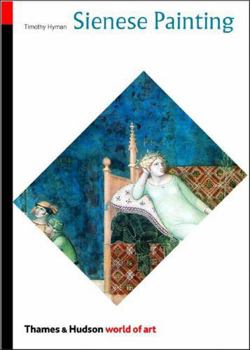Sienese Painting: The Art of a City-Republic (1278-1477)
(Part of the World of Art Series and World of Art Series)
A practicing artist, author, and curator, Timothy Hyman guides us through the golden age of Sienese painting, offering a new perspective on some of the world's most beautiful paintings, including Duccio's Maesta and Ambrogio Lorenzetti's famous Good Government frescoes. A sound understanding of the art and history of the period underpins the author's clearly conveyed love of the works. He takes a broadly chronological approach, with each chapter looking...
Format:Paperback
Language:English
ISBN:0500203725
ISBN13:9780500203729
Release Date:November 2003
Publisher:Thames & Hudson
Length:224 Pages
Weight:1.04 lbs.
Dimensions:0.6" x 6.0" x 8.5"
Customer Reviews
3 ratings
Wonderful and Beautiful
Published by Thriftbooks.com User , 18 years ago
This is a beautifully written exploration of the work produced in Siena over a two-century period of glory, during which artists like Martini, Sassetta, and Giovanni di Paolo pioneered new narrative techniques. For anyone who has seen or read about these groundbreaking freschi and paintings, which include Lorenzetti's magnificent depictions of Good and Bad Government, this book is a must, since Hyman is able to put such masterpieces into a political and social context. The author writes intelligently throughout, working his research expertly into the text. Happily, he completely avoids the obfuscation and silly post-modern jargon that generally characterize art criticism. I cannot recommend this book highly enough. (And if Hyman's analysis of Sienese life and art doesn't make you want to visit Italy, I can't imagine what could!)
A Very Good Introduction
Published by Thriftbooks.com User , 20 years ago
Clear and concise, enthusiastic and insightful, this book provides a very useful introduction to Sienese art. It traces its roots and development, links it to the political state of affairs in Siena and Italy, and contrasts it with the art of Florence, which ended up eclipsing it. The main Sienese artists are discussed in their own chapters, and a clear line of development is laid out, though at the same time the individual characteristics of each artist are discussed. The book is generally very readable and it is clearly laid out and structured.My only quibble is the fact that so many of the illustrations are black and white. This is particularly annoying in cases where the author is discussing the subtlety of the color!That point notwithstanding, anyone looking for a basic introduction to the art of Siena need not hesitate.
Sienese Painting Discussed by a Painter
Published by Thriftbooks.com User , 21 years ago
Any reader who is familiar with Timothy Hyman's BONNARD will be pleased to find the same clarity, depth of knowledge, and instructional vision in his treatment of Sienese painting (SIENESE PAINTING: THE ART OF A CITY REPUBLIC is in the same beautiful small-book format as BONNARD).Hyman is an odd bird as fas as the art history publishing world is concerned. He is an accomplished artist, but when he puts his energy toward his parallel careers in curating and writing, he knows his stuff just as thoroughly as any other more conventional art history scholar. This comes as a blessing for the general reader as well as historian because he has the gift to blend human feeling and sparkling vision with academics in a highly readable way.And he makes the material so CLEAR. At the very outset with his discussion of the physical description of the city and the governing body known as "The Nine", the foundation is set to build his elegant story of the city's glorious paintings. The governing principles of Siena were almost Athenian in their idealism, and were cautiously balanced against aggressive clan and economic forces. Somehow the author makes the reader see that the colorated delicacy of Sienese painting is a very logical outgrowth of these various opposing powers.It didn't used to be all right (critically) to like Sienese painting too much. Duccio--OK, and the Lorenzetti, also. But mainly, Sienese painting wasn't considered "progressive" enough by the Renaissance standards that were constructed by later historians.The republic's painting paled in the shadow of mighty and magnificent Florence with it's army of artists who defended artistic soverignty. Well, all the silly prejudice that was perpetrated on unknowning art students for generations is cleared away once and for all by Mr. Hyman. Just as he convinced us that it's more than all right to love mature Bonnard,the artist-author persuades the reader of the excitement, superb beauty, and compelling legitimacy of Sienese painting.His descriptions shimmer. How many times have I seen Ambrogio Lorenzetti's Good and Bad Government? After reading his discussion of it, it seemed like the first time. Siena excelled in color, pattern, landscape and narrative--and, dare I say it? Tenderness. Go ahead, let your heart break a little when you see Sassetta or a Giovanni di Paolo, Hyman seems to say. It's OK! He concludes by giving several examples of contemporary artists whose works are sympathetic to the directions first begun by Sienese forebears.






